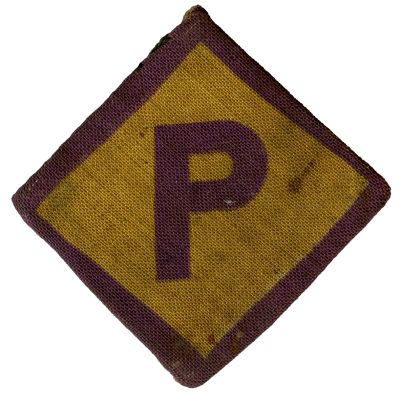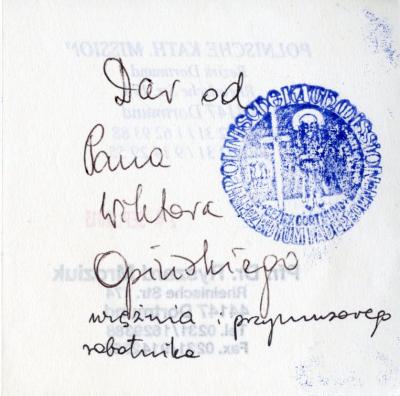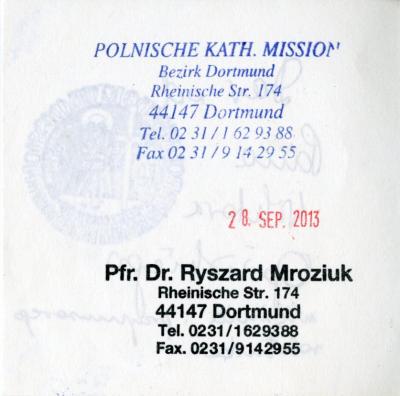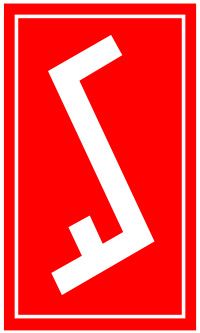The letter „P“

The Nazis were obsessed with the idea of categorising people according to various criteria, primarily according to race. That said it was difficult to assign many people to a category according to their appearance. In order to ensure that people could be recognised as “inferior” within this absurd, perfidious and finally tragic system of racist segregation, a number of different insignia were introduced soon after the beginning of the war. Starting in autumn 1939 Jews were forced to wear a yellow Star of David in the occupied areas; and from 1941 onwards in the area of the Reich. A badge with the letter ‘P’ was introduced for Polish forced labourers in March 1940. The forced labourers– and these included a huge number of Poles – who were moved into the Reich from the newly occupied areas after the invasion of the Soviet Union were forced to wear a piece of cloth with the white word “Ost” (East) on a blue background. Concentration camps also had their own elaborate rules for categorising prisoners.
Whereas the Jewish population in the area of the Reich were rapidly forced out of public life, deported and exterminated, and the number of yellow Stars of David sank accordingly, the number of badges with the letter P rose in millions as people from Polish areas were brought to the West to replace male workers in agricultural and industrial regions who had been sent to fight and die at the front. All in all during the Second World War around 2,800,000 Poles worked within the borders of the Reich, of whom around 95% were recruited by force.
The categorisation of Poles was regulated by the so-called “Polish Edicts” of 8th March 1940 and by several other related orders. The wording read: “From the first day of work we must ensure that Polish workers will be recognised as such at any time and by everyone. The badges are exclusively there to serve this necessity. There is no intention to defame these people thereby.” But this was of course exactly what was intended. The badge, according to a police regulation was to be “always worn in a visible manner… on the right-hand side of the chest”. It consisted “of a 5 cm square standing on one of its corners with a 2½ cm violet P against a yellow background on a half centimetre wide violet border.” The highly unusual choice of colour and shape was supposedly meant to avoid any association with Polish national symbols. The “Petka“, as the badge was known to the Poles, stigmatised the forced labourers in public. This explains why they continually tried to conceal it beneath the lapels of their jackets outside their places of work, or attempted to remove it completely. Such attempts might end disastrously. Zbyszko Matuszewski remembers: “Heaven help you if you forgot your P. The first time you had to pay a penalty of 10 Marks. And the second time even more. And after they caught you a few more times you were dispatched to a penal colony. No, they didn’t catch me so often. I only had to pay penalties.” Indeed at the end of 1941 the following decree was issued :“(…) Anyone who is caught on more than one occasion without a P badge [is to be] taken to the state police headquarters for further treatment.” What “further treatment” actually meant remained vague, but it could indicate the worst possible treatment. Nonetheless there was still a great temptation to go out onto the streets without the ‘P’, even perhaps – and this was forbidden like so many other things – to go to the cinema. “We girls mostly concealed our ‘P’s“ said Irina G.
Julian Banaś, who was forced to work in a Volkswagen factory, left behind comprehensive details about the way he wore his badge: “The camp had two gates and two guards. (…) [There] you were checked to see if your ‘P’ was sewn on. The ‘P’ was a sign of discrimination. I wasn’t ashamed of wearing the ‘P’ because I was a Pole. But I only wore the ‘P’ because I didn’t want to be kicked indiscriminately and be forced to listen to unpleasant and insulting remarks. Since the factory guards always checked whether the ‘P’ was sewn on, I used a coloured thread to sew around the piece of cloth with the letter P. It didn’t match properly and indeed really stuck out. But people could see that it was sewn on. I then fastened the badge with a pin. As soon as I had passed the guards I folded it together and stuck it in my pocket!”
In some factories there were even more refined categorisations. One of these was the Schichau docks in Elbing. Jan Uskwarek, who was forced to work there in 1943, remembers an unintentionally comic scene which might have ended very badly. He was ordered to wear an A (‘Ausländer’: the German word for foreigner) alongside his P – and in every section of the factory the ‘A’s had a different colour. One day a bug crawled under one of these badges just as it was being checked. “The foreman pointed at me with his pencil and asked if that was proof of Polish cleanliness. I felt insulted and replied that it wasn’t my fault. ‘And whose fault is it supposed to be’, he roared back at me, red with rage”. Luckily the situation did not escalate further and later Uskwarek explained to the foreman the reason why the bug had appeared – the forced labourers were only given a small piece of cheap soap once a month and they also had to wash with it; and the hygienic conditions in the camp barracks were anything but good.
The experiences of Polish forced labourers in the Reich were ambivalent. Since they were stigmatised in public and discriminated by a huge number of regulations everything was a matter of chance. Life was often worse in factories because here they were shut up in camps and at the mercy of arbitrary despotism. Furthermore their work became more and more dangerous as the factories were increasingly subject to air-raids. True, work in the countryside was also hard but life could be bearable there depending on which farm you were assigned to. Quite often Polish workers even took their meals with the farmer’s family, something which was strictly forbidden. Romantic relationships between Germans and Poles were equally forbidden. Any Pole who got involved with farm girls whose husbands were serving in the war, or with unmarried girls, was threatened with the gallows; whereas the German women were often pilloried as Polish sluts and sent to a concentration camp. Towards the end of the war when the lack of workers in German industry became ever more drastic, people tried to improve conditions for the forced labourers although the terrible state of food supplies often worked against this. In January 1945 the Central Office for Reich Security put forward proposals for a new Polish badge, a yellow ear of corn on a red and white label – but these were never put into practice.
Peter Oliver Loew, November 2014
![Poster "P" of the Volksbund für das Deutschtum im Ausland Poster "P" of the Volksbund für das Deutschtum im Ausland - Collection Porta Polonica [from BPK]](/sites/default/files/styles/width_100_tiles/public/assets/images/plakat_p.jpg?itok=3tWI7KyG)




